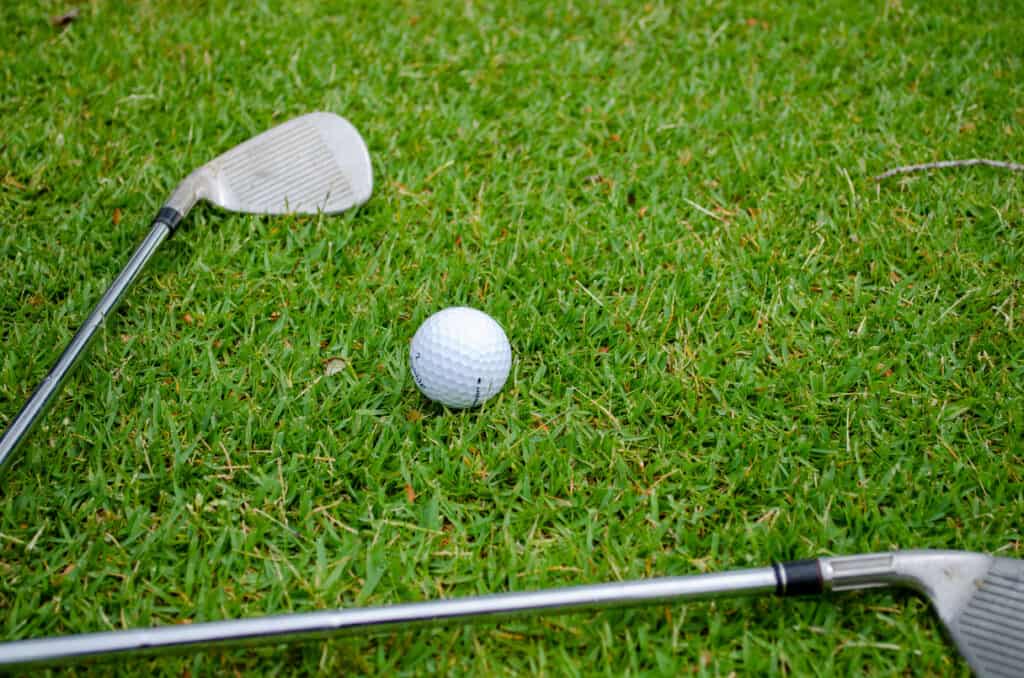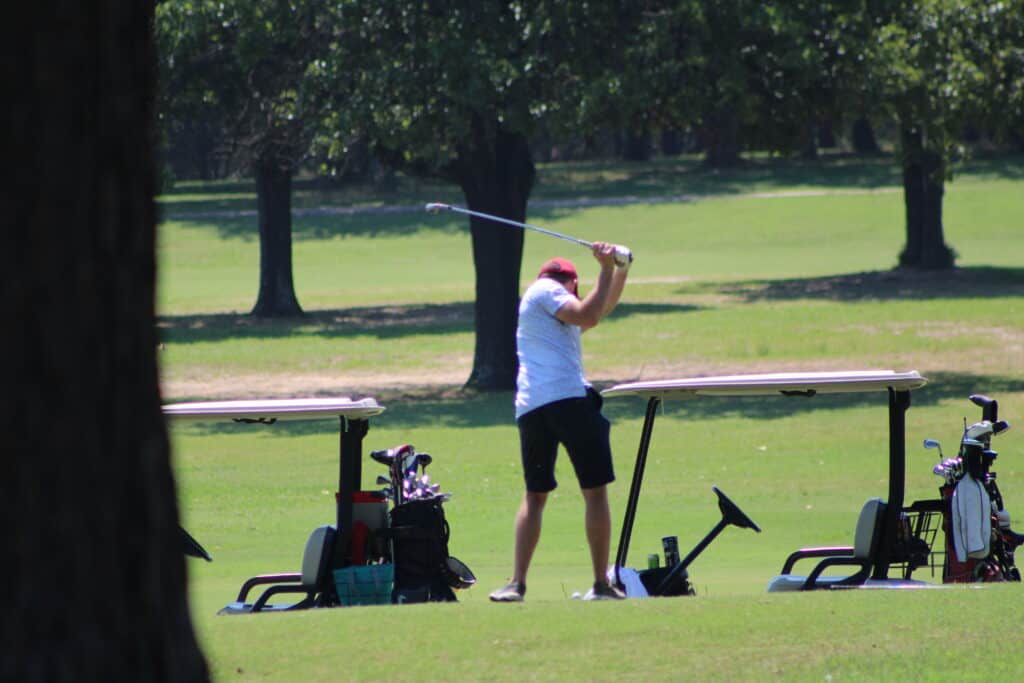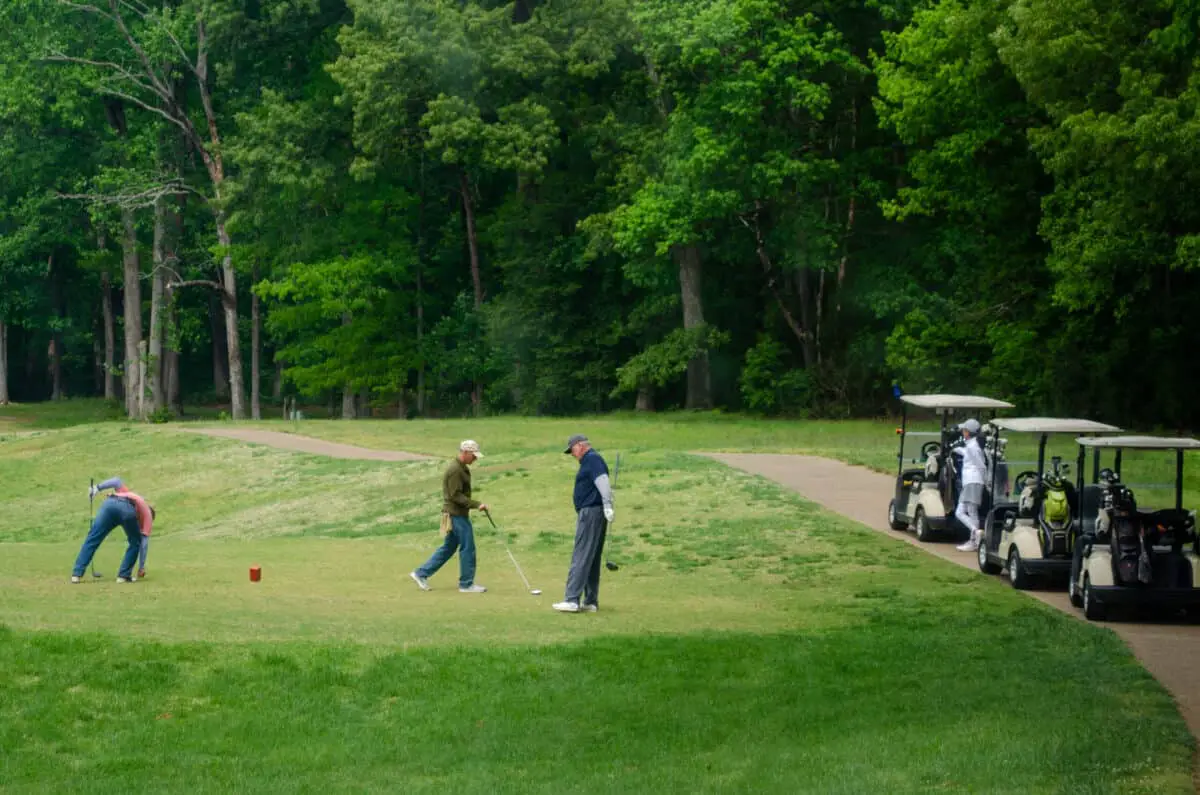You might be forgiven for thinking that the 2 iron and 3 iron have more in common with the dinosaurs than they do with the modern game of golf, and to a point, you would be right.
Aside from the loft and the length, the 2-iron is less lofted and slightly longer. The 2-iron golf club is still considered a driving iron, while the 3-iron is usually the longest iron in your bag and is used for long approach shots from the fairway or for long par three tee shots on occasion.
Nowadays, you don’t see many of either in the golf bags of most golfers, pros to mid to high handicapper, as between the hybrid or fairway wood, not many players use the two or 3-iron anymore.
The average golfer struggles to hit long irons, even the best driving irons, with their low loft and since they are not a versatile club are often left out of the golfers bag. But let’s take a look at these two legendary golf clubs side by side.
Long Irons – Loft & Sweet Spots
First off, let’s look at the loft on these golf clubs and what you would find in place of them in the golf bag.
The two iron would typically have a loft of between 17 and 19 degrees, while the three iron has a 20 or 21 degrees loft. The difference in loft equates to lower spin and more distance for the two iron, while the three iron would have a higher trajectory with more spin.

As you can see, the clubs cover the loft gap between them perfectly, and the two iron would have been the 2nd lowest lofted golf club next to the 1-iron, which we all know “only God And Goats can hit.”
In traditional bags, the one iron and two iron would have been the two driving irons, while the 3-iron would have been the start of the playing irons.
Both irons would have had a relatively small sweet spot making them the domain of pro golfers or low-mid handicap players with great swing technique, as there is virtually no forgiveness for a miscued strike with either of these irons.
Hitting a two-iron or three-iron flush was and is difficult for many golfers, and this is why you don’t see these clubs in too many bags in the modern game.
2 Iron Vs 3 Iron – Which Is Easier To Hit
The two iron with its lower loft would be more difficult to get airborne and offer less forgiveness than the three iron. Still, it would give you more distance and offer some additional versatility as the loft approaches driver levels.
The three-iron is easier to hit and get airborne than the two-iron but would give you less distance with a higher golf ball flight, and because the loft is higher, there would be more spin.
Due to the higher loft, the three iron would not have as much versatility as the three iron, where manufactured low running shots or hitting into stiff breezes would be required.
While it may be slightly more forgiving than the two-iron, neither have the forgiveness of either their equivalent fairway wood or hybrids.
2 Iron Vs 3 Iron – Application On The Course
With the very low lofts, long graphite or steel shaft, and lie angles, these clubs would have been used to get more control over greater distances, and both are still available today. However, they conform more to the modern design and profile than their traditional counterparts.
Driving irons like the 2-iron were used off the tee to deliver penetrating golf ball flights and achieve distances up between 200 and 250 yards, while the 3-iron would have been used for longer approach shots with more control and shaping for distances from 180 to 200 yards, as well as the odd low bunt or stinger.
If you have the ability and the confidence to swing them, you could achieve some incredible shots like the 2 iron that Tiger Woods hit from 275 yards out at the Memorial in 1999 to within a few feet of the flag.

You may have thought that shot inspired more players to carry the 2 iron in their bags, but that was not the case. Tiger’s shot and the fact that he was one of the few that still carried a 2-iron, while other pros and players opt for hybrids or fairway woods which are easier to hit consistently.
Are 2 Irons And 3 Irons Still Available
Even though you don’t see either golf club as part of a standard set these days, some current iron manufacturers still offer both the 2 iron and three iron, and for skilled players that struggle with fairway woods or utility clubs, these clubs remain an option.
Still, they would be purchased individually as they are no longer part of the standard set configuration.
PING, Callaway, Titleist, Cobra, and Taylormade all make and offer 2 irons, and Callaway, Cobra, and Titleist offer 3-irons in a ‘players range.’ Still, for the most part, no current, complete iron sets carry a 3-iron; they are all 4-iron to PW.
Are There Any Pros That Have A 2 or 3 Iron
Matt Jones, Aaron Wise, and Lanto Griffin all have 2 irons in their bags, and Tiger, of course, had one as well when he was at his prime. As for the three iron, only about 20% of PGA tour players carry a three-iron that isn’t a utility golf club, and that number is virtually zero for the lady’s tour.
This is because modern hybrid clubs offer more forgiveness and more distance than the three iron or 2 iron.
Coupled with that, they are difficult to hit well even for the top players; it is easier to use hybrid clubs that will induce confidence in the swing rather than traditional irons that may not.
2 Iron Vs. 3 Iron – Current Replacements
The inherent difficulty in consistently striking the sweet spot on both of these clubs has led to them being replaced with clubs that are easier to swing and achieve professional contact.
Before the advent of the hybrid clubs, players would replace the 2 iron and three iron with the three wood and five wood, respectively. The lofts in the woods were pretty close to that of the 2 and 3 irons.
If you look at the modern three wood, it has a loft of around 15 degrees, giving it less loft than the 2 iron. At the same time, the five fairway wood has a loft of approximately 20 degrees which is virtually the same as the three iron.
Fairway woods for most golfers, especially the amateur and high handicap players, the three wood and five wood are easier to hit as they have more prominent sweet spots than their iron counterparts and often are far more forgiving.
Still, a miscued strike from a three or five wood will be in trouble, but maybe not as much as one off the face of a 2 iron or three iron.
As hybrid clubs became more popular with both amateurs and pros alike, low lofted hybrid clubs with lofts between 14-17 degrees stepped in to replace the 3-wood, while slightly more lofted hybrids with 18-21 degree lofts replaced the five wood.
These days, players have a multitude of clubs to choose from, and depending on which they find easier to swing and make quality contact with, players can carry a mixed bag with standard irons and the choice of fairway woods or hybrid longer clubs.
2 Iron Vs. 3 Iron – Who Should Use Them
First off, beginners and high handicap golfers should NOT have either in their bags as they will genuinely struggle to hit them successfully and get rid of them in a very short space of time for longer clubs they can hit.
Even mid-handicap players would struggle with these clubs, and this is why many of them golf sets aimed at these players do not include a three-iron, much less a 2-iron.
Another consideration is the swing speed. Clubs that have low lofts and a long steel shaft or graphite shaft require higher swing speeds to get the ball airborne and spinning with what little spin they offer.
Players with slower swing speeds would typically opt for hybrids or fairway woods which ties in with why 2 iron and three irons are virtually unseen in the professional ladies’ game – the naturally slower swing speeds producing slower ball speed would be a barrier to using these clubs successfully in tournaments.
The Case For Both Clubs In The Bag
Good ball strikers could consider having the 2 iron, and 3 iron in their bags as these long driving irons offer greater control and shaping ability than the fairway woods and hybrids. Another factor is where golfers find they get too much spin and height from the five wood and require a golf club that provides less of both.
These lower lofted clubs could be a viable option for courses where the wind is a constant factor as they would offer low ball flight and lower spin off the tee and give greater distance than a fairway wood or hybrid could do.
As mentioned before, where some players struggle with fairway woods or hybrids, the 2 iron and three iron may be a potential option. However, the options and variety of modern fairway woods and hybrids will gradually eliminate the return of the 2 iron or three iron.
Modern technology has made the fairway woods and hybrids so easy to swing consistently for players of all swing speeds that the era of the driving iron and the three iron is fading fast.
The fact remains that despite tradition, golfers of all skill levels will opt for clubs that are easier to hit accurately and consistently straight and far, and this will seal the fate of the 2 iron and 3 iron for good.
Before discounting either of these clubs, see if you can find some old ones or buy a cheap one online or from a second-hand selection at your pro shop and take it to the range and test it out.
If you do hit your long iron well and enjoy the feel and tradition of the long clubs, you may well find your sweet spot waiting for you in a 2 iron or 3 iron. There is great satisfaction in striking either of those well, and the flight and distance results could be equally gratifying.
Long Irons Transformed?
While the 2-iron and three-iron in their traditional form have mostly faded as a very low lofted iron, they may not have disappeared but instead been recreated as other modernized clubs in the golf bag with similar lofts?
In the ’90s, you would typically see 3-irons with a 21-degree loft. Before that, in the 80s and 70s, lofts on the 2 iron of around 20 degrees, with the one long iron having the lowest loft and the 2-iron being the lowest lofted golf club in the set.
Now, consider that the modern four iron has an average loft of 20.6 degrees, that is the loft of the three iron of days past- so has the 3-iron actually vanished or simply been recreated?
Taking the lofts of multiple four iron models from the top manufacturers, the lofts ranged from 24 degrees in the Titleist T 100 and Mizuno JPX 921 Tour to 18 degrees in the Callaway Mavrik and TaylorMade Sim OS MAX.
Between those two, there were 19,20,21, 22 and 23 degrees and averaging them out came to 20.6 degrees.
So now you have three wood, five wood, and longer irons that run from 4 iron to PW, and the fairway woods have lower lofts for more distance than the three iron and 2 iron had- so, in the quest for the greater distance, we have ‘transformed’ the 2-iron and 3-iron into the low lofted hybrids and fairway woods we see today.
Conclusion
With more players on both the PGA and LPGA tours and other prominent tours like the European tour replacing longer irons with hybrids, it would seem as though the classic long irons will be remanded to annals of history.
It may well be soon that golf club manufacturers cease production of both the 2 iron and three iron as demand for these clubs will fade, but based on the lofted evidence above, it would be more prudent to think that, like much in the game of golf, they have merely been transformed for the modern game.
2 Iron vs 3 Iron FAQ’s
How many pros carry a 3 iron?
The number of professional golfers who carry a 3 iron in their bag has decreased significantly in recent years. Many professional golfers have opted to replace their 3 iron with higher-lofted utility irons, hybrids, or long irons. These modern clubs offer more forgiveness, distance, and versatility compared to traditional 3 irons.
The decision to carry a 3 iron or its equivalent depends on a golfer’s individual preference, course conditions, and playing style. Some professionals may still choose to carry a 3 iron if they feel it suits their game, but it has become less common in favor of more modern and forgiving alternatives.
Where should the ball be in your stance with a 2 iron?
The ball position in your stance when using a 2 iron can vary depending on your swing and the shot you want to play. As a general guideline, for a standard shot with a 2 iron, you should position the ball just inside your left heel (for right-handed golfers).
This placement helps ensure clean contact with the ball and allows you to strike down on it to achieve a lower trajectory.
However, if you want to hit a lower, more controlled shot, you can move the ball slightly back in your stance.
Conversely, if you want to hit a higher shot, you can move it slightly forward. Experiment with different ball positions on the practice range to find what works best for your swing and the specific shot you’re trying to execute.
Can you tee off with a 2 iron?
Yes, you can tee off with a 2 iron, but it’s not the most common choice for most golfers. A 2 iron is a low-lofted club designed for long shots from the fairway and is not typically used for tee shots on par-4 or par-5 holes.
Most golfers prefer to use drivers or fairway woods for tee shots as they provide more forgiveness and distance. However, if you are comfortable and confident in your ability to control a 2 iron off the tee, there’s no rule preventing you from doing so.
- Should Tee Boxes Be Level? - January 23, 2024
- 3 Hybrid Distance - November 15, 2023
- Innovations in Golf Mobility: An In-depth Review of Top Golf Scooters - October 12, 2023

